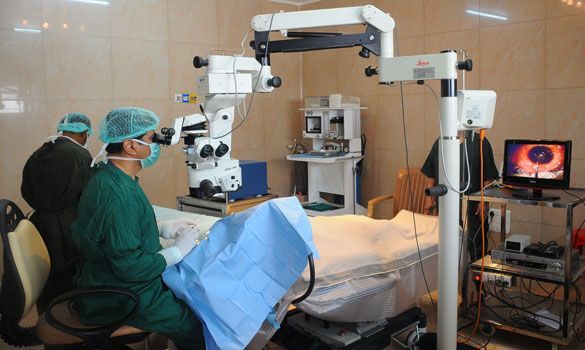Phakic Intraocular Lens
What is a Phakic Intraocular Lens?
A Phakic Intraocular Lens (PIOL), commonly called an Implantable Phakic Contact Lens, is a biocompatible, foldable lens implanted inside the eye to correct myopia (short sight), hyperopia (long sight), Presbyopia (Chaleese) and astigmatism.
Unlike LASIK, PRK, SMILE or SILK no treatment is performed on the cornea. The ICL is positioned behind the iris and in front of the natural crystalline lens, and so is suitable for patients who are unfit for corneal procedures. Those with thin corneas, dry eyes, high refractive powers etc. can consider this implantation
The Procedure
1. Preoperative Evaluation
Detailed eye examination include Biomicroscopy, detailed phoropter refraction, Pentacam HR, corneal topography, optical Biometry, non-contact tonometry, specular endothelial cell count, white to white limbal measurement, anterior chamber depth and angle evaluation, dilated retinal assessment etc.
2. Surgery
- The Anesthesiologist will monitor your health during the surgery. No injections are needed, and the totally painless surgery is performed under anesthetic drops. Remain calm, quiet and relaxed. If you need to move your arms or legs, cough or sneeze, please inform the surgeon before doing so. Keep both your eyes open throughout the surgery and blink normally. Follow surgeon's instructions.
- A single micro-incision is made, and the foldable lens is inserted & carefully positioned behind the iris. This is a highly skilled micro-surgery & takes about 15 minutes to complete. You will be inside the operation theatre complex for about 30-60 minutes.
- One eye is operated at a time, and the other can be scheduled in few days.
3. Post operative Care
- You can proceed home in about 2 hours after the surgery after receiving post operative instructions. Keep both the eyes closed and take rest on the day of surgery. Open both your eyes while walking, eating etc. You can eat your normal food and take your usual medicines. Avoid TV, digital monitors and mobile phones for one day.
- Instil eye drops as advised. Some irritation, pricking, watering, & blurred vision are common on the day of surgery. If there is pain or any other symptoms, take a pain tablet and inform us on phone.
- Vision improves in 24–48 hours.
POST SURGERY
01
Recovery & Care
- Do not touch, rub or press your eyes for about a month.
- Follow instructions about eye care, eye drops, & follow up visits.
- Wear goggles for protection for 1 month, both indoors and outdoors.
- Sleep with protective eye shield for one week. Avoid pressure on eye with your arm or pillow while sleeping.
- Light activities like reading, computer work, TV, walking) can be resumed in 1 day
- Driving can be done once vision stabilizes.
- Follow-up with us at 1 day, 1 week and 1 month following surgery. Do call us if there is any new symptom, pain or blurring.
02
Restrictions for 4 weeks
- Avoid swimming, contact sports, injuries & strenuous exercises
- Avoid eye makeup and dusty or windy environments
- Avoid dental / ENT procedures and any other surgeries for one month
03
Potential Risks
While modern Phakic IOL’s are very popular & safe, risks include:
- Opacities in the natural lens
- Raised intraocular pressure & glaucoma
- Endothelial cell loss
- Infections
- Malposition and rotation of Phakic lens
Operation Theatres at Karthik Netralaya

Sophisticated equipment are used in our ultra-modern, NABH accredited, vaastu compliant operation theatres. Each operation theatre has independent AHU with HEPA filters and laminar flow. Dehumidifiers, UV lights, modern B class autoclave with Nano-auto controller for multiple pre-vacuum and post dry cycles, graphic monitor, Ethylene oxide sterilizer, central water treatment plant etc. make the surgeries very safe.
Strict aseptic protocols are meticulously followed. Each surgery is completely isolated from others and nothing is transferred from one to the next. Quality medicines and disposables are obtained from renowned manufacturers and stored scientifically. Nothing is prescribed to the patient or fetched from local pharmacies.
Why Choose Karthik Netralaya?
- NABH-accredited premier tertiary eye care centre
- Best operation theatres
- Decades of first hand experience in performing these as well as very complex surgeries
- Experienced & highly skilled senior super specialist surgeons perform these delicate & precision micro-surgeries
- State-of-the-art modern diagnostic technology and surgical equipment are used
- Consistently excellent outcomes with a focus on patient safety and care.
